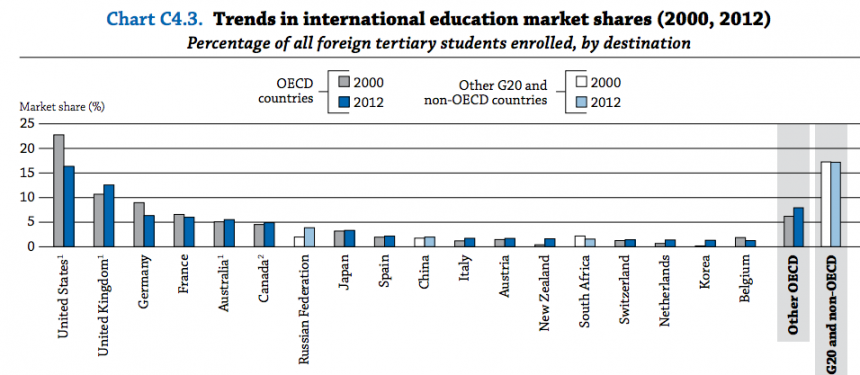Some 4.5 million students studied abroad in 2012, but growth has slowed compared to previous years, the latest Education at a Glance report from the Organisation for Economic Cooperation and Development (OECD), the most thorough international student market report available, reveals.
News and business analysis for Professionals in International Education
Have some pie!
Global student mobility growth slowing, OECD report shows
 A graph from the report showing the proportion of international students in different countries
A graph from the report showing the proportion of international students in different countries The report shows that although international student mobility has increased more than fivefold since 1965, when just 800,000 students ventured abroad, this year’s 2.5% growth is down compared to the 7% average annual increase between 2000 and 2012.
Six countries received more than half the world’s international students
The report attributed the slowing to “shrinking support” for financial assistance such as grants and scholarships in the current economic climate, as well as the impact of the global recession on individuals’ finances.
Six countries received more than half the world’s international students, but the report shows that Russia, Japan, Spain, China, Italy, Austria, New Zealand, Switzerland, Korea and the Netherlands all increased their market share between 2000 and 2012.
The US retained its lead as the country welcoming the most international students, though its market share fell 1% to 16% – a further sign that its market dominance is slipping as competitor countries gain ground and non-traditional destinations emerge.
The UK followed with an unchanged 13% share; France, Germany and Australia each had 6% of incoming students; and Canada had 5%.
The statistics indicate that demand for highly qualified immigrant workers remains strong. All of the countries included in the report apart from Germany had a larger proportion of international students enrolled in advanced research programmes than in any other tertiary-level courses, including 80% of Luxembourg’s incoming students. International students account for more than 50% of all students enrolled on these programmes in Switzerland, and over 40% of total enrolments in New Zealand and the United Kingdom.
OECD countries received more than three times the number of students they sent abroad in 2012. In the OECD’s 21 European member countries there were three foreign students for every European citizen enrolled abroad, while in Australia the ratio of incoming to outgoing students was 18 to one.
Australia’s incoming to outgoing student ration is notably higher even than its direct competitor countries the UK, New Zealand and the US, which had 13, 12 and 11 international students to each student they sent abroad, although incoming student numbers in the US and UK are in fact much higher.
Students from Asia accounted for 53% of the world’s foreign students with China, India and Korea the largest source markets
Luxembourg had the highest proportion of international students in its higher education sector by a large margin, accounting for 41% of total enrolment.
International students also represented a significant share of tertiary enrolments in Australia (18%), the UK (17%), Switzerland (16%), New Zealand (16%) and Austria (15%).
Outbound mobility has remained fairly stable. As in the previous year, students from Asia accounted for 53% of the world’s foreign students with China, India and Korea the largest source markets.
This figure – 1,662,788 – is more than double the number of international students coming into Asia, despite a 59% increase between 2000 and 2012.
Africa shows a similar pattern, with incoming student numbers standing at around half the number it sends abroad, after doubling to 196,568 over the same time period. Meanwhile, Latin America saw nearly three times the number of incoming students – 71,468 – going abroad to study.
Still looking? Find by category:



2 Responses to Global student mobility growth slowing, OECD report shows